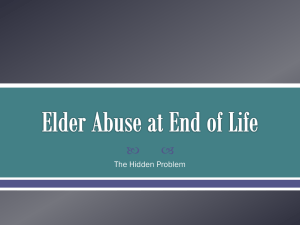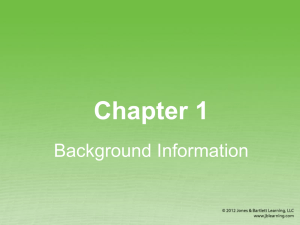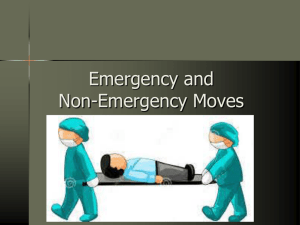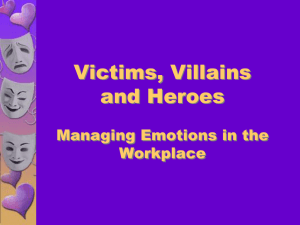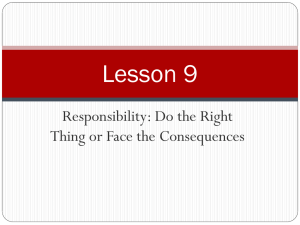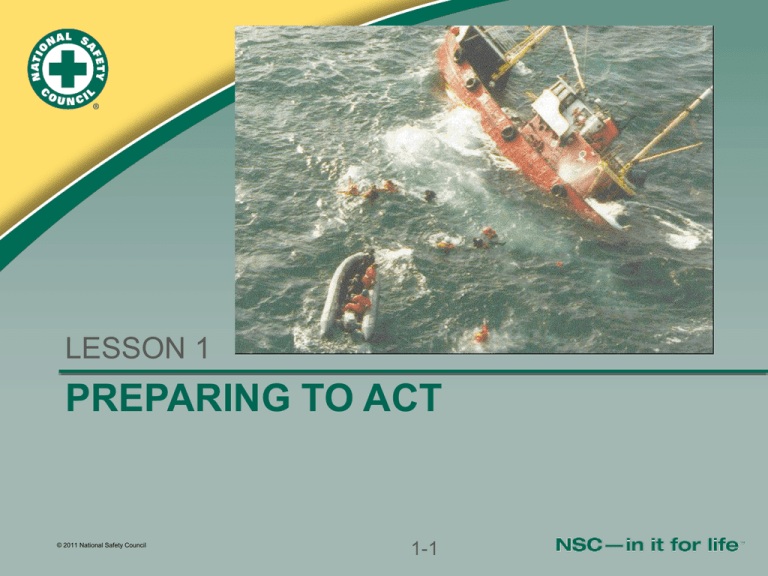
LESSON 1
PREPARING TO ACT
© 2011 National Safety Council
1-1
First Aid Training is Important
• Can happen to
anyone, any time
• Injury and sudden
illness require
immediate attention
• Life or well being often
depends on first aid
© 2011 National Safety Council
1-2
What is First Aid?
• Immediate help given to victim of injury or sudden
illness
• Help given before victim sees health care provider
• Help typically given by friend, family member, coworker or bystander
• Help given using minimal or no medical equipment
© 2011 National Safety Council
1-3
Primary Goals of First Aid
• Keep victim alive
• Prevent victim’s
condition from getting
worse
• Help promote early
recovery
• Ensure victim receives
appropriate medical
care
© 2011 National Safety Council
1-4
The Need for First Aid
• Heart disease is the most common cause of death,
resulting in about 616,000 deaths a year
• Over 1,250,000 heart attacks occur, resulting in over
132,000 deaths
• About 795,000 people a year have a stroke, resulting
in about 136,000 deaths
• About 124,200 die from unintentional injuries
• About 39 million visits are made to emergency
departments because of injuries
© 2011 National Safety Council
1-5
Deciding to Help
Common Concerns-barriers to action
• Worried about not doing right thing
• Think someone else will provide better care
• Not sure it is an emergency
• Upset by sight of blood or injury
• Worried about catching a disease
© 2011 National Safety Council
1-6
Stay Prepared to Help
• Know appropriate first aid
• Be confident
• Have a first aid kit
• Know 9-1-1 and other
emergency numbers
• Teach children to call
9-1-1 not 9-eleven
• Make others aware of
medical conditions
© 2011 National Safety Council
1-7
Emergency Medical Service System
• Dispatcher
- Receives call, gathers
information, sends help
• Emergency medical
responders
- First to arrive and take
over care
• EMTs/paramedics
- Give more advanced
care and transport victim
© 2011 National Safety Council
1-8
When to Call 9-1-1
• Victim may have life-threatening condition
• Victim is unresponsive
• Victim’s condition may become life-threatening
• Moving victim could make condition worse
• Do not transport the victim yourself
© 2011 National Safety Council
1-9
Call 9-1-1
• Unresponsive or AMS
• Vomiting blood
• Not breathing/difficulty
breathing
• Seizures
• Chest pain/discomfort
• Drowning
• Severe bleeding
• Threatened suicide
• Head or spine injury
• Imminent childbirth
• Severe burn
• Poisoning/drug
overdose
© 2011 National Safety Council
1-10
Other Reasons to Call 9-1-1
• Fire, explosion
• Vehicle crash
• Downed electrical wire
• Chemical spill, gas leak, unknown substances present
• Swiftly moving or rapidly rising water
© 2011 National Safety Council
1-11
When You Call 9-1-1
Have this information ready:
• Your name and phone number you are using
• The location and number of victims
• What happened/special circumstances
• Victim’s condition
• Victim’s sex and approximate age
• What is being done for victim(s)
© 2011 National Safety Council
1-12
Can You Be Sued?
Not if you:
• Act only as you are trained to act.
• Get a victim’s consent before giving first aid.
• Do not move a victim unnecessarily.
• Call for professional help.
• Keep giving care until help arrives.
© 2011 National Safety Council
1-13
Good Samaritan Laws
Protect you:
• When acting in an emergency, voluntarily and without
compensation
• When acting as a reasonable, prudent person with
the same training would act
• When performing first aid only as trained
• If you do not abandon the victim after starting to give
care
• ..\..\Kenny\FA Stuff\Washington Laws 1975.doc
© 2011 National Safety Council
1-14
Must You Give First Aid?
• Usually not as a bystander
• May feel an ethical or moral obligation
• Legal obligations:
- If you start first aid, you must continue
- If first aid is included in your job
- If you are responsible for a child
© 2011 National Safety Council
1-15
Consent
• Responsive victim
must give consent
- Tell person your training
and what you will do to
help
© 2011 National Safety Council
1-16
Implied Consent
• Unresponsive victim assumed to give consent
• Consent assumed for child needing first aid if
parent/guardian not present
© 2011 National Safety Council
1-17
Refusal of Care
• Competent adult has right to refuse care
• May not be competent because of:
- Intoxication
- Influence of drug
- Altered mental status from injury or diabetic emergency
© 2011 National Safety Council
1-18
Refusal of Care
continued
• If victim refuses:
- Call 9-1-1
- Keep talking but do not argue
- Ensure there is a witness to the refusal
© 2011 National Safety Council
1-19
Scope of Care
• Perform only the techniques in which you are trained
- Trying anything else may make you legally liable
© 2011 National Safety Council
1-20
Negligence
• May be negligent only if three conditions exist:
- You have a duty to act
- You breach that duty
- Your actions (or inactions) cause injury or damage
© 2011 National Safety Council
1-21
Examples of Negligence
Examples:
• Moving a victim unnecessarily
• Doing something you have not been trained to do
• Failing to give first aid as you have been trained
© 2011 National Safety Council
1-22
Abandonment
• Once you start, don’t stop!
- Another person with the same or higher level of training may
take over
• Stay with victim until help arrives
- If you leave and injury/illness becomes worse this is
abandonment
© 2011 National Safety Council
1-23
Stopping Care
Justified instances of
stopping care:
• Exhausted and unable
to continue
• Being in imminent
danger
© 2011 National Safety Council
1-24
Confidentiality
• Never give out private information about victim
- Unless it is to health care professionals who are caring for
victim
© 2011 National Safety Council
1-25
Being Prepared
• Teach children how to call for help as soon as can use
phone
• Keep emergency phone #’s and contacts by your phone
or in first aid kit
• Have an up-to-date first aid kid at your home, workplace,
and automobile (page 7)
• Learn and practice first aid and CPR skills
© 2011 National Safety Council
Scenario
A motorcycle with two riders weaves dangerously between
parked cars in a crowded shopping center parking lot. As the
cyclists dart between cars, they confront a moving car. Both
the car and cycle veer to avoid a head-on collision. The cycle
strikes the side of the oncoming car, throwing the riders to
the ground. The car stops abruptly, throwing the driver into
the windshield.
Nearby, Jamie and Paul (two college students) hear the sound
of crunching metal and blaring horns and decide to join the
small group of bystanders. As they approach the scene, they
are confronted with the sight of broken glass, strewn metal
and a cracked windshield. A gas cap lies nearby, and they
notice what appears to be gasoline, which has spilled from
the motorcycle onto the roadway. One victim screams in pain
as she sits holding her injured arm. The other victim lies
motionless.
© 2011 National Safety Council
1-27
Two people wearing safety belts are inside the
stopped car. The driver appears to be shaken.
Several onlookers turn away, apparently unable to
cope with what they see. Other bystanders
continue to gather. As Jamie and Paul look around,
no one seems to be helping. They hesitate,
wondering whether they should step forward to
help.
What would you do?
© 2011 National Safety Council
1-28



